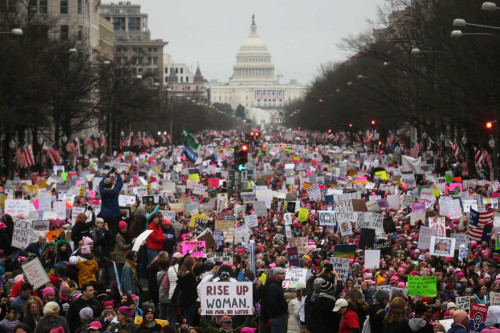
Image from New York Magazine
While January 20th ushered in what some may call the era of “Alternative facts, a.k.a the Trump presidency, the 21st brought a pushback from feminism and its allies in the form of what some estimate was the largest protest in U.S. history—arguably shadowing the inauguration by sheer numbers (a half million to one million in D.C. and 4.5 million nationally)—serving as a reminder of the strength in solidarity.
In a time of severe divisiveness, white-knuckled partisanship and disheartening lines in the sand, the Women’s March on Washington reminded people of their promise not to normalize a post-Trump America. Conceptualized as a reflex to Trump’s policy plans, the day after he was elected Teresa Shook of Hawaii invited friends via Facebook to march in D.C.
Soon, similar invites spread through the Internet and other organizational efforts began by those who would become co-chairs such as fashion designer Bob Bland, executive director of the Arab American Association of New York,Linda Sarsour and Carmen Perez.
The grassroots march spread internationally, with events overseas including England and France in protest of Trump’s win. Future marchers found specifically problematic the ultra-conservative and alt-right nature of his circle and followers, with Sarsour referencing the event as “A stand on social justice and human rights issues ranging from race, ethnicity, gender, religion immigration and healthcare.”
While chairs avoided directly calling the women’s march a campaign against Trump, chants aimed at the president peppered the event including the amusing: “We want a leader, not a creepy tweeter!”
At the event itself, the marchers were more inclined to pinpoint their anger, as pink knit hats, coined “pussy hats” replaced the droves of infamous red “Make American Great Again” caps from the day before, of course referencing the female genitalia a then business mogul was recorded stating he could “grab.” One woman, giving out hand made hats and cat ears explained, “I hate Trump so much, I learned to knit.”
These everyday people weren’t alone in their disdain, as the list of speakers and performers seemed an embarrassment of liberal riches especially when following the inauguration, notorious for the entertainers who declined, backed out or received backlash for accepting the invitation, such as R&B/Soul singer Chrisette Michele. Speakers included Planned Parenthood president Cecile Richards, actress Scarlett Johansson, legendary activist Angela Davis (delivering one of the most memorable speeches of the day, stating “History cannot be deleted like web pages!”) prominent feminist Gloria Steinem, CNN’s Van Jones and Malcom X’s daughter, Ilyasah Shabazz, plus many more.
Though the march was peaceful, it was not without criticism. The Trump administration officially responded to the protests the next day. According to an NBC News article, the march was condemned for allegedly banning pro-life organizations (even though small groups of pro-life supporters were indeed in attendance) stating, “It’s a shame that the March for Life, which estimates the same number of marchers in DC (650,000 in 2013) and will be happening next Friday, will not get anywhere near the same amount of coverage that this march got-and those pro-life members were NOT welcome at the Women’s March.” Pop legend Madonna was also blasted for stating that she thought about blowing up the White House. On Trump’s own twitter he taunted protesters with the questionable observation, “Watched protests yesterday but was under the impression that we just had an election! Why didn’t these people vote? Celebs hurt cause badly.” He made no mention of the fact that he did, as a matter of fact, lose the popular vote.
Overall however, the atmosphere was a showing in what unification can do.The march didn’t just take place internationally, international bodies showed up. At one point a large group of Canadian protesters, dressed alike and holding banners, were asked what brought them. They replied simply, “We felt like you needed us here so, we are here.”
Such was the attitude of the day, of unity and the promise, that in these uncertain times for the marginalized or minorities of any kind there would be a hand in the dark.
